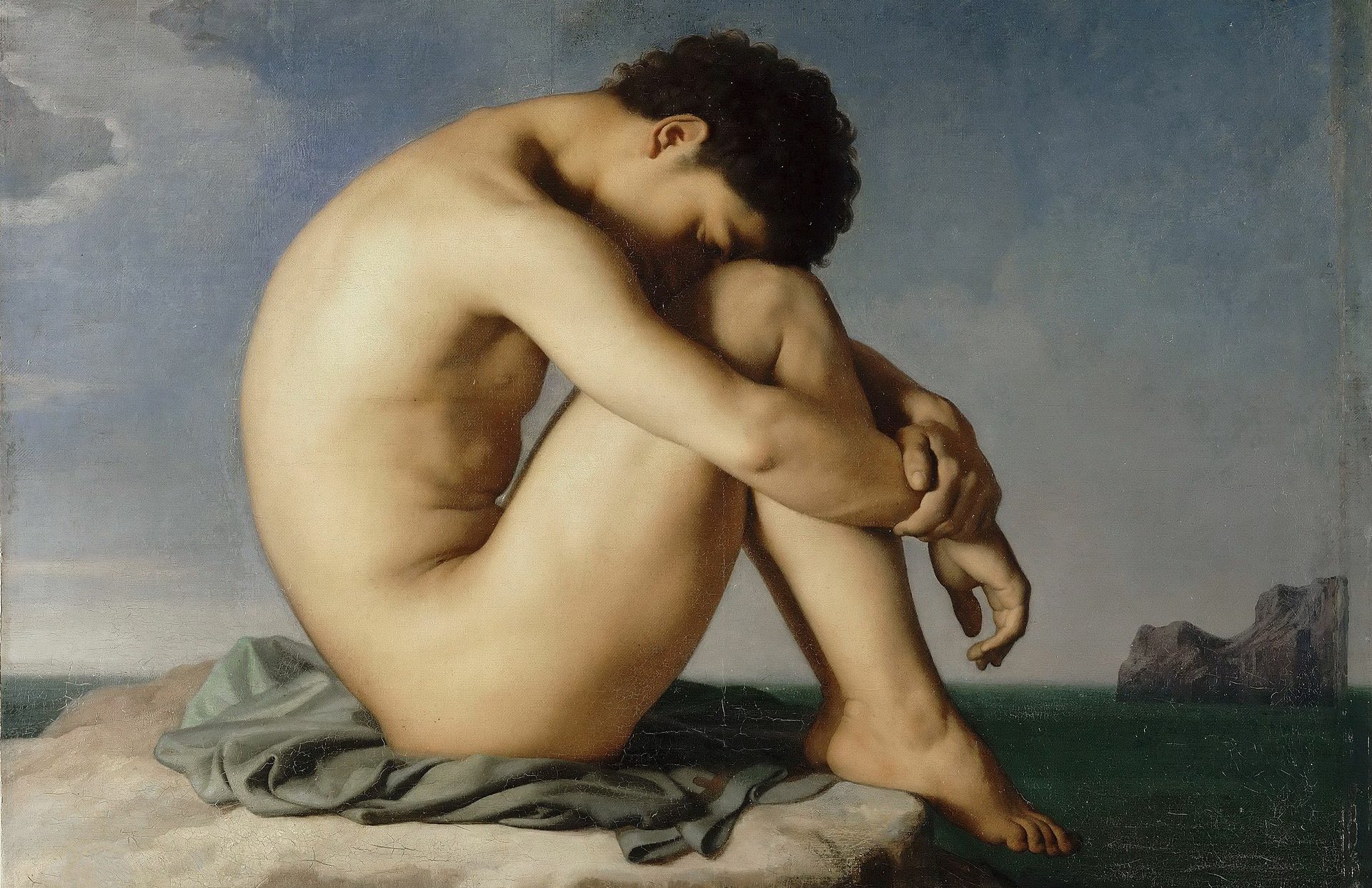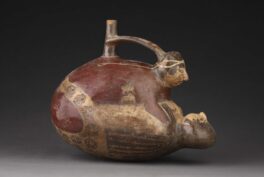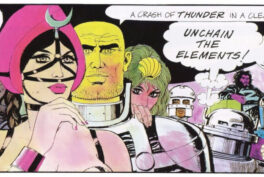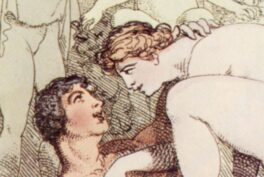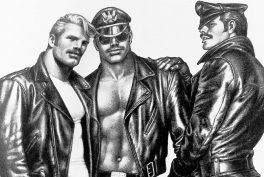Summary
The greatest male nudes in art history are:
- smiling male nudes in the mythological context by Annibale Carracci, Caravaggio, and Carlo Levi,
- an iconic image of a nude in Soviet art by Kuzma Petrov-Vodkin,
- a naked Narcissus by Jules-Cyrille Cavé,
- Anne-Louis Girodet’s sleeping Endymion,
- Michelangelo’s Adam from the Sistine Chapel as a lazy nude,
- Abel by Camille Felix Bellanger,
- Evelyn de Morgan’s Morning and Evening stars as male nudes,
- Jean-Hippolyte Flandrin’s Young Male like Da Vinci’s Vitruvian Man,
- Jacques-Louis David’s Neoclassical nude,
- Koloman Moser’s joyful, naked Spring,
- El Greco’s Saint Sebastian, the Catholic saint and a gay icon,
- the rebelious nudes by Peter Paul Rubens and Alexandre Cabanel,
- Charles Paul London’s ambitious Icarus,
- affectionate Young Boy with a Cat by Pierre-Auuste Renoir,
- François-Léon Benouville’s angry Achilles,
- athletic Ring Gymnast by Eugène Jansson,
- bathing nudes painted by Gustave Caillebotte, Thomas Eakins, Edvard Munch, and Henry Scott Tuke,
- Frédéric Bazille’s fisherman at work,
- naked self-portraits by Albrecht Dürer, Richard Gerstl, Egon Schiele, and Lucian Freud,
- nude studies by Jean-Auguste-Dominique Ingres, Théodore Chasseriau, and Edgar Degas,
- the realistic nudes painted by William Etty.
The Smiling Nudes
Annibale Carracci
Annibale Carracci (1560-1609) was an Italian painter, famous in Bologna and Rome. He was one of the promoters of the Baroque style of paintings. In Bacchus, Carracci creates a well-known figure from classical Greek mythology – Bacchus or Dionysus, the God of wine and merry-making. Here, Bacchus, is a handsome young man with golden ringlets, standing in an isolated landscape with his cup of wine. His pose is relaxed and he is staring right at the viewers, inviting them to join him for a drink.
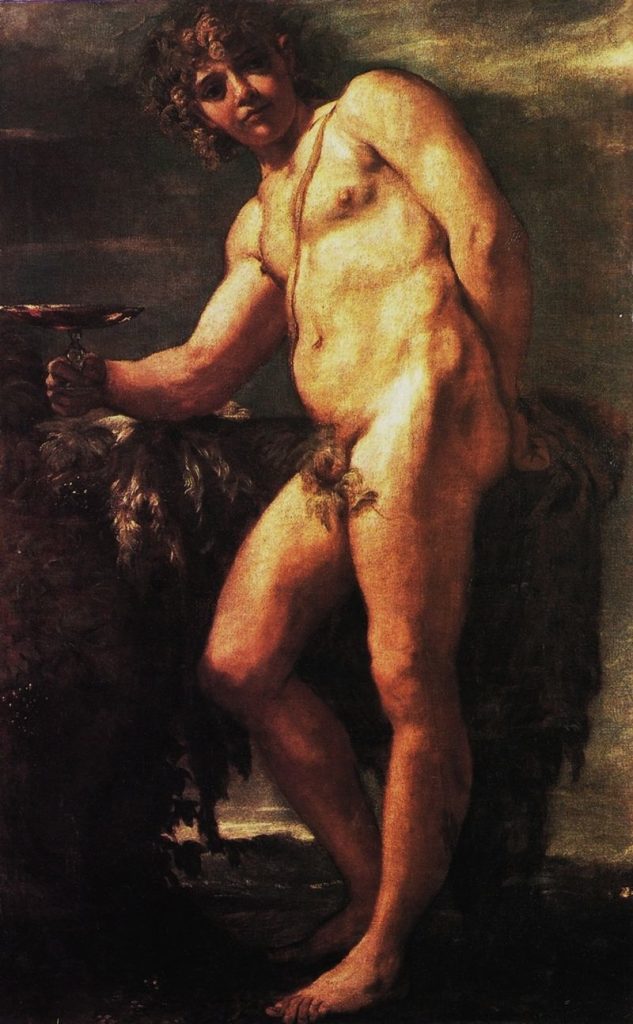
Male nudes in art: Annibale Carracci, Bacchus, ca. 1590-1591, National Museum of Capodimonte, Naples, Italy.
Caravaggio
Born in Milan, Caravaggio (1571-1610) moved to Rome where he was known mainly for his large religious paintings. In classical mythology, Cupid is the god of erotic love, desire, and attraction. He is presented as the son of Venus, goddess of love, and Mars, the god of war. Like Carracci’s Bacchus, in Victorious Cupid, Cupid is also portrayed as half-child and half-man.
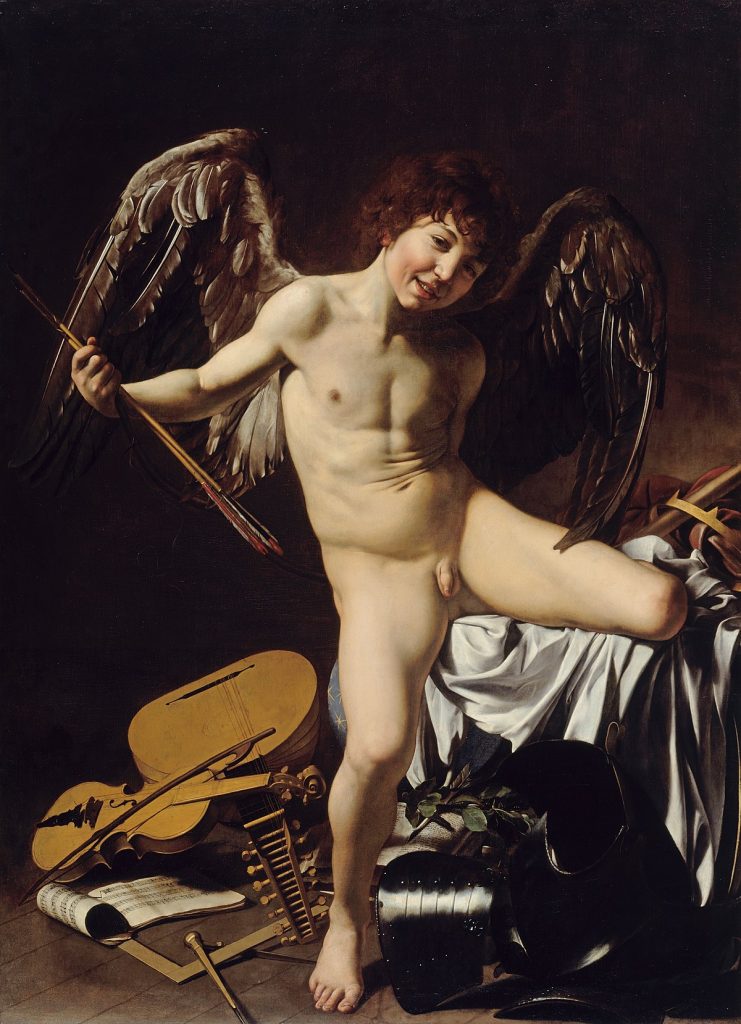
Male nudes in art: Caravaggio, Amor Vincit Omnia (Love Conquers All), Victorious Cupid, 1602, Gemaldegalerie SMPK, Berlin, Germany.
The model for Cupid was Cecco, Caravaggio’s servant, pupil, and possibly lover. The painting is really the portrait of Cecco rather than Cupid. He is obviously delighted to be dressed up as the god of love! There are various objects in the paintings like a geometry set, armor, a violin, a manuscript of musical notes and a crown of leaves, but all are meaningless when love strikes. Notice the arrows he is clutching in his hand, ready to strike again.
Carlo Levi
Carlo Levi (1902-1975) was an Italian painter, writer, doctor, and political activist. Levi was well aware of the poverty in southern Italy compared to the northern parts. Considering that the painting is named Arcadia it was also a political commentary on the situation in Italy.
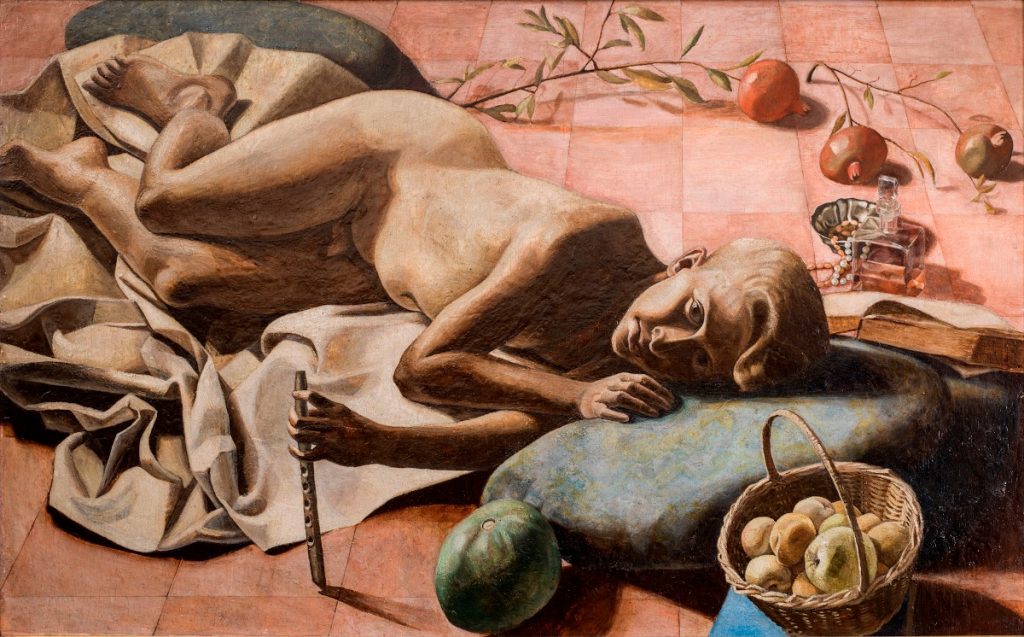
Male nudes in art: Carlo Levi, Arcadia, 1923, private collection, currently on loan to Ministry of Foreign Affairs and International Cooperation, Rome, Italy.
Arcadia was a mythical place in ancient Greece. It symbolized pastoralism and harmony with the natural world. It is an idyllic, uncorrupted world of shepherds. Arcadia shows a young naked boy lying with a flute in his hand. The boy appears to be a young shepherd and his nakedness suggests his closeness to nature. The boy’s gaze is directed at the viewer. The fruits in the painting refer to the bounty of nature. However, the open book, the bottle of perfume, and a necklace represent knowledge and luxury, and suggest that Arcadia is not so innocent and idyllic anymore.
The Playful Nudes
Kuzma Sergeevich Petrov-Vodkin
Kuzma Sergeevich Petrov-Vodkin (1878-1939) was a Soviet-Russian painter and writer. Boys (Boys Playing) was an iconic painting for Petrov-Vodkin and the Soviet culture.
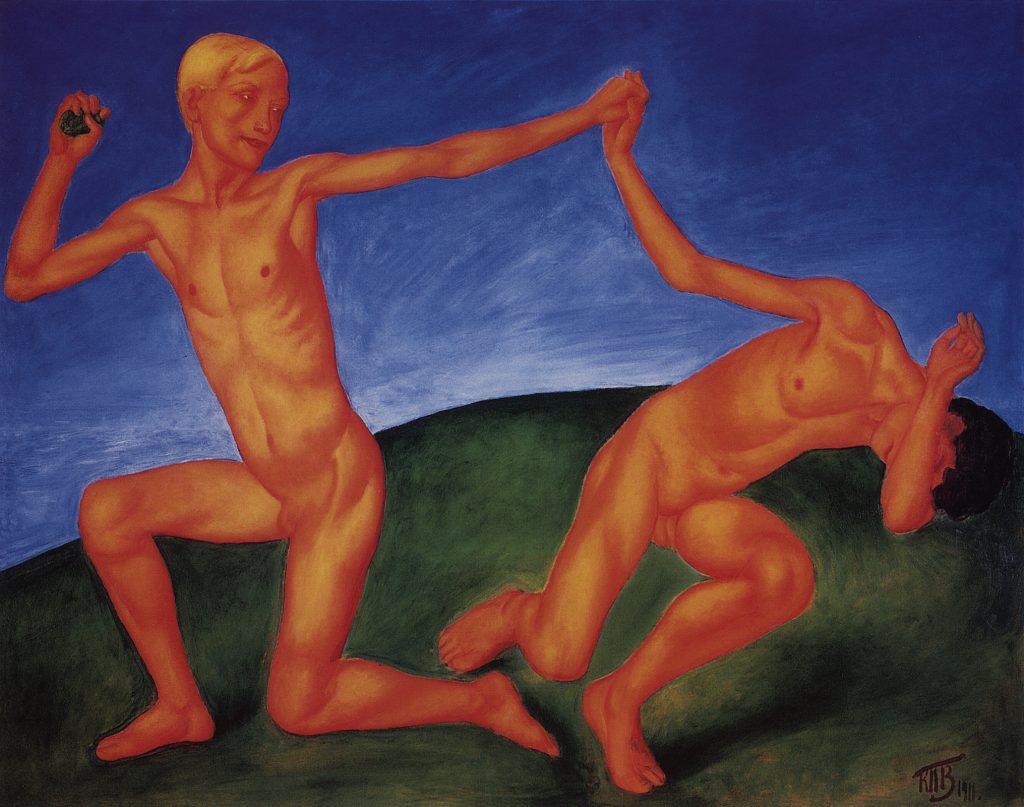
Male nudes in art: Kuzma Petrov-Vodkin, Boys (Boys Playing), 1911, The State Russian Museum, St.Petersburg, Russia.
The two nude boys are seen playing in the background of green and blue. Their bodies are young, tall, lanky, and occupying the whole canvas. They are contorted in playful poses. Petrov-Vodkin was inspired by two boys playing on a beach and the painting generated a powerful emotional impact. The use of three primary colors is deliberate – yellow-red, green, and blue. Contrasted against the rigidity of modern Soviet rule, the painting evoked the carefree and colorful world of childhood.
The Nude in Love
Jules-Cyrille Cavé
Very little is known about the personal life of Jules-Cyrille Cavé (1859-1940). He was a French painter and known for his genre scenes and floral still life paintings.
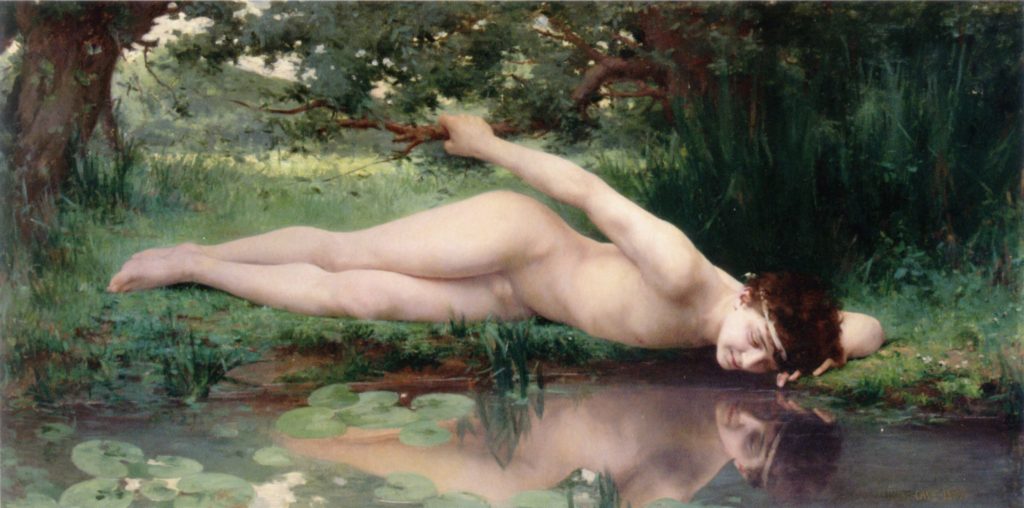
Male nudes in art: Jules-Cyrille Cavé, Narcissus, 1890, private collection. Wikimedia Commons (public domain).
Cavé’s Narcissus depicts a popular story from Ovid’s Metamorphosis. Echo, the nymph who fell in love with the handsome youth Narcissus is missing in the painting. The figure is holding onto a branch with one hand, his reclining body almost at the edge of the pond. The figure is painted in the classical tradition of idealism and simplicity, but his arms are well-sculpted for a young man of 15. Narcissus fell deeply in love with himself, and Cavé painted the moment when he is about to kiss his own reflection. Sadly, Narcissus was cursed, he drowned and died.
The Sleeping Nude
Anne-Louis Girodet
Anne-Louis Girodet de Roussy-Trioson (1767-1824) was a French painter and pupil of Jacques-Louis David, whose painting is also here in the article!
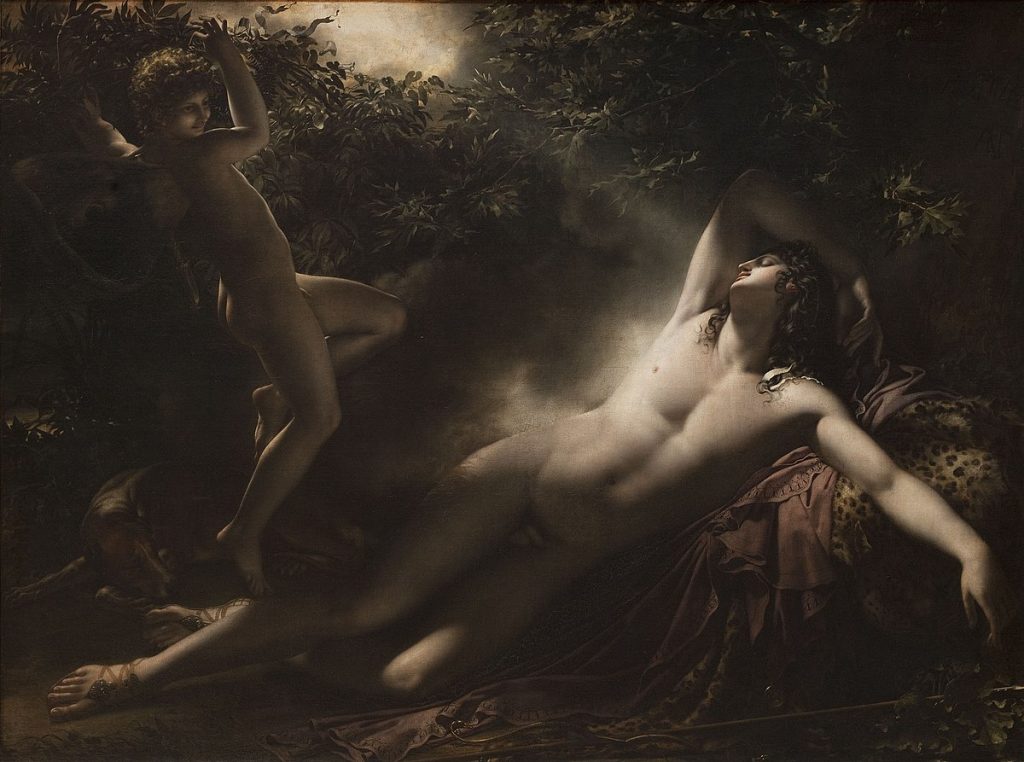
Male nudes in art: Anne-Louis Girodet, The Sleep of Endymion, 1791, Musée du Louvre, Paris, France.
In The Sleep of Endymion, also called Effet de lune or “effect of the Moon”, the mythical figure of Endymion is androgynous. Although the true identity of Endymion is not known, it is assumed he was a shepherd of ideal beauty. In The Sleep of Endymion, he is visited by Diana as a moonbeam. A Zephyr holds back the leaves, so the light falls on Endymion. The pose and the ideal nude suggest classical influence but the mysterious light is hinting at the romantic sensibility.
The Lazy Nude
Michelangelo
Michelangelo di Lodovico Buonarroti Simoni (1475–1564) was born in Florence and is known as simply Michelangelo. He was an Italian sculptor, painter, architect, and poet of the High Renaissance.
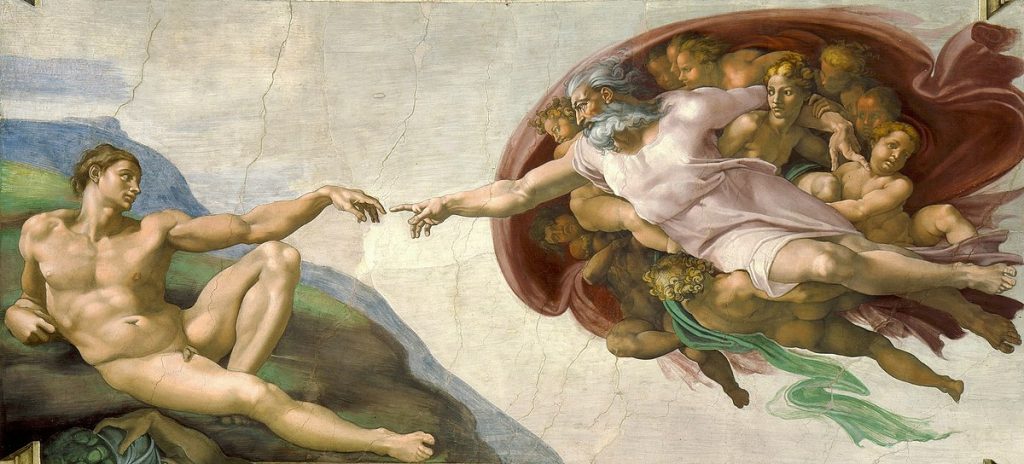
Male nudes in art: Michelangelo, The Creation of Adam, c. 1512, Sistine Chapel, Vatican City, Vatican.
The Creation of Adam was painted on the ceiling of the Sistine Chapel between 1508 and 1512. The lazy nude here is Adam who is extending his hand in response to God. God’s touch will give him life and lead to the birth of the human race. God and Adam are both depicted as muscular and appear more like the artist’s sculptures.
The Lifeless Nude
Camille Felix Bellanger
Camille Felix Bellanger (1853-1923) was born in Paris and Abel (Death of Abel) won him a prestigious art scholarship at Prix de Rome. Bellanger was a dedicated artist and teacher.
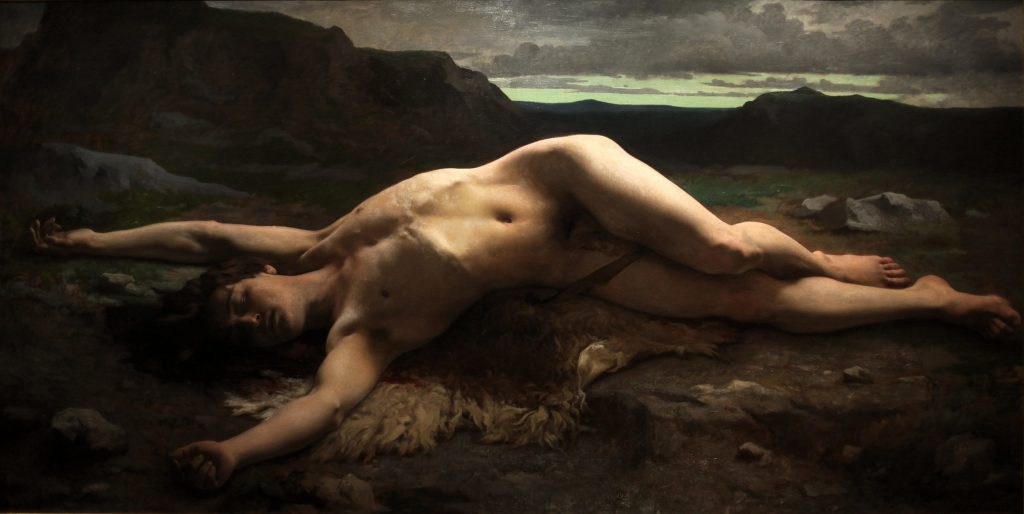
Male nudes in art history: Camille Felix Bellanger, Abel (Death of Abel), 1875, Musée d’Orsay, Paris, France.
In this youthful image, the twisted nude body of murdered Abel lies in a rocky landscape, mystically highlighted with a heavenly light. Bellanger captured the contrapposto skilfully. Contrapposto is an Italian term that means counterpoise, a technique used in visual arts where the weight of the body is on one foot.
The Cosmic Nudes
Evelyn De Morgan
The only woman artist to figure in this article, Evelyn De Morgan (1855-1919) was a painter who defied the expectations of her class and gender to become one of the most impressive British artists.
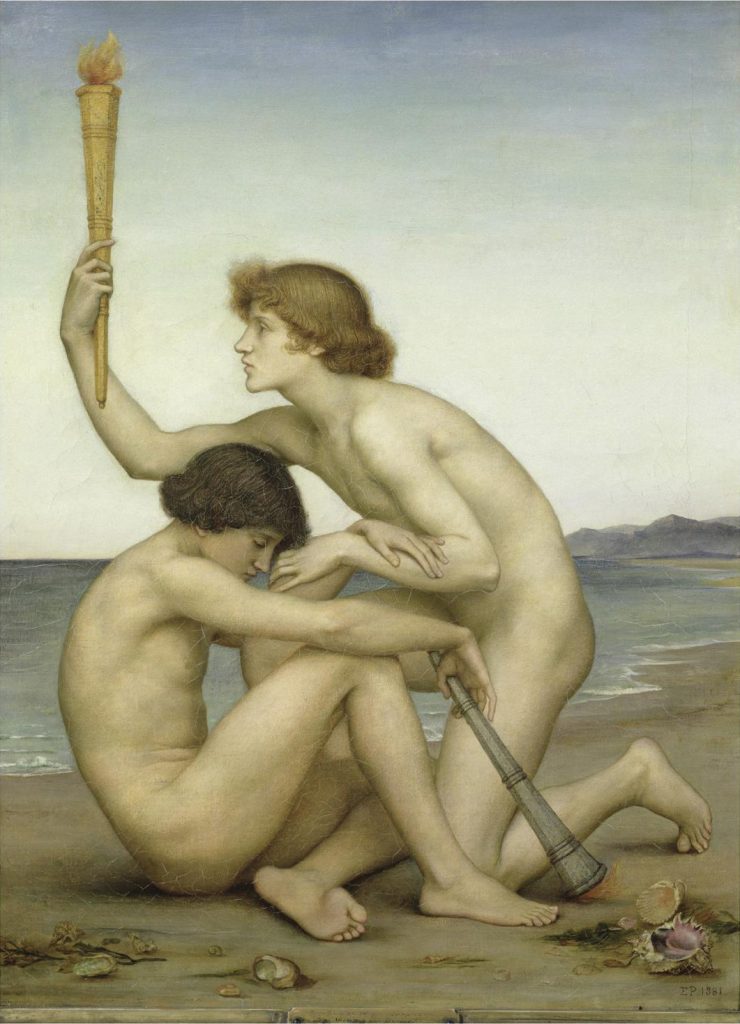
Male nudes in art: Evelyn De Morgan, Phosphorus and Hesperus, 1881, De Morgan Collection, Surrey, UK.
Inspired by Greek mythology, Phosphorus and Hesperus depicts the Morning star Phosphorus and the Evening star Hesperus. The painting alludes to the circle of life, Phosphorus is rising, his torch is lit and the sky behind him is light blue. In contrast, Hesperus’ evening starlight is fading. His torch is burning out, his eyes are closing and the sea behind him is darkening. The two male figures are almost sculpture-like and the sea shells refer to female fertility. The painting was well received but with some controversy, as it came from a woman artist, after all.
The Solitary Nude
Jean-Hippolyte Flandrin
Jean-Hippolyte Flandrin (1809-1864) was a 19th-century French painter.
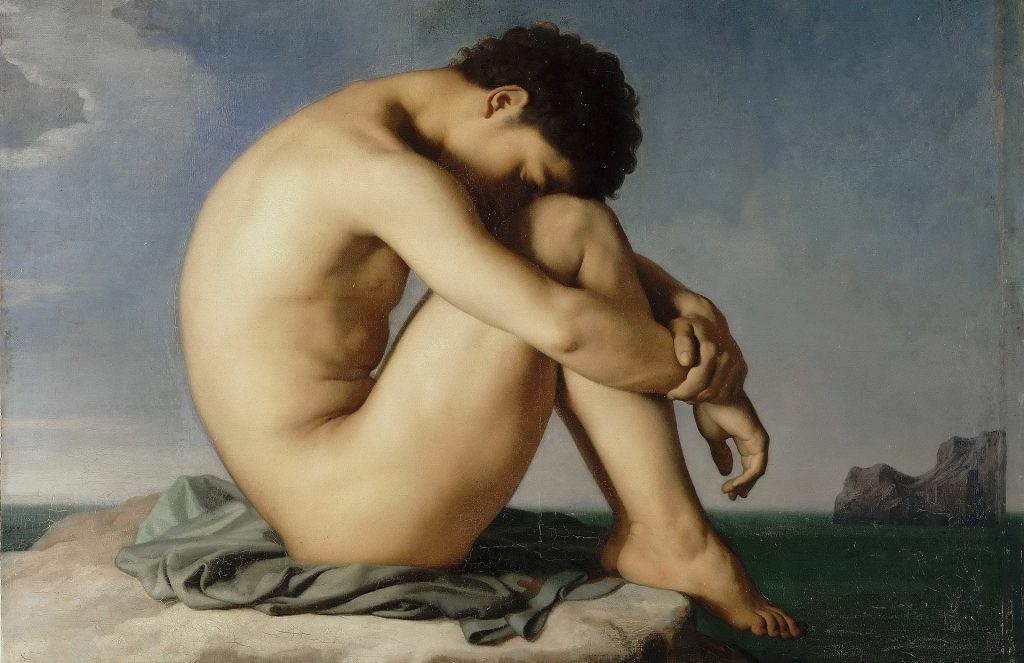
Male nudes in art: Jean-Hippolyte Flandrin, Study, Young Male Nude Seated Beside the Sea, 1836, Musée du Louvre, Paris, France.
Young Male Nude Seated Beside the Sea (also as Étude de nu) is a study work painted in Rome. The unidentified youth sits on a rock, head resting on his knees and eyes closed. The sea is the only background. There are many suggestions regarding the youth: a shipwrecked man or a shepherd. The almost circular pose of the figure is compared to Leonardo da Vinci’s Vitruvian Man. The painting also became an icon in gay culture.
The Shy Nude
Jacques-Louis David
Jacques-Louis David (1748-1825) was a French painter in the Neoclassical style. He was the teacher of Anne-Louis Girodet who painted The Sleeping Endymion. David was known to have developed the Empire style, notable for its use of warm Venetian colors.
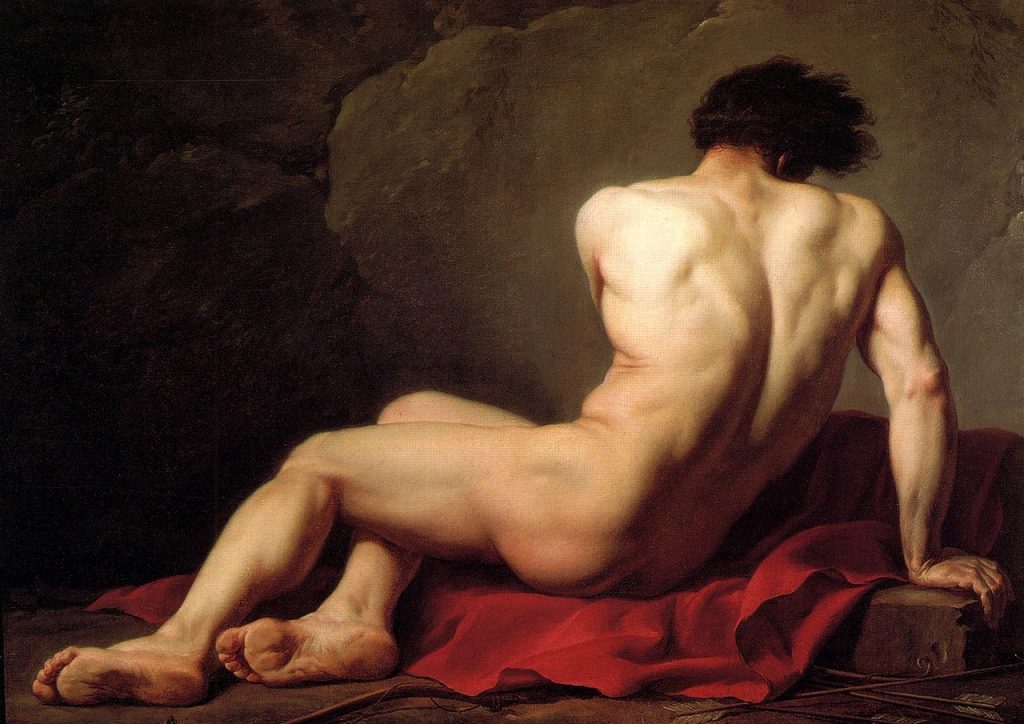
Male nudes in art: Jacques Louis David, Male Nude known as Patroclus, 1780, Musee d’Art Thomas Henry, Cherbourg, France.
Patroclus was a character from Homer’s Iliad (c.1260-1180 BCE) who died fighting the Trojans. In Male Nude known as Patroclus, David uses light and shadow to bring out the muscular stature of the nude figure. He is not facing the viewer, but it is a difficult pose to hold since all his weight is held on his right arm.
The Happy Nude
Koloman Moser
Koloman Moser (1868-1918) was a multi-talented Austrian artist. He was a leading 20th-century graphic artist and a member of the Vienna Secession movement.
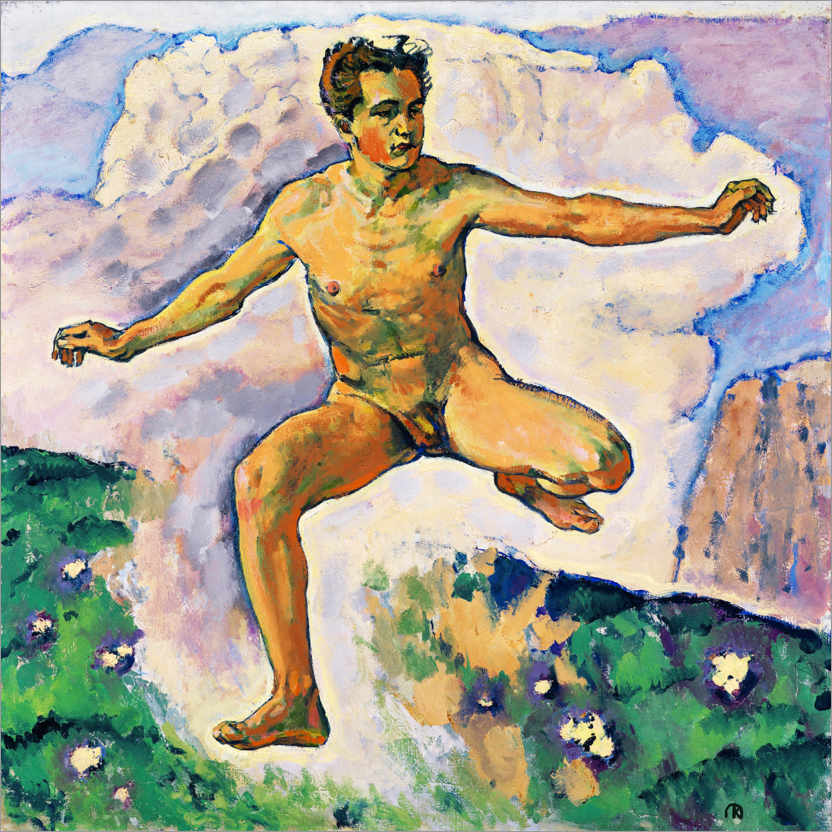
Male nudes in art: Koloman Moser, Frühling (Spring), 1900, Leopold Museum, Vienna, Austria.
In Frühling (Spring) the unidentified young man is leaping in excitement. Although his expression is sober, with his arms raised sideways, and legs barely touching the ground, the energy of the young man is infectious. The green foreground and the flowers suggest it is indeed springtime!
The Nude as Icon
El Greco
Doménikos Theotokópoulos (1541-1614) known as El Greco was a Greek painter and architect of Spanish Mannerism. However, he always signed his paintings in his full name but in Greek letters, as seen in Saint Sebastian.
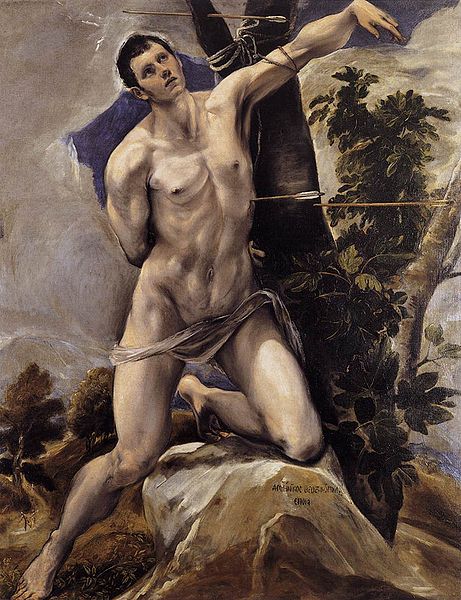
Male nudes in art: El Greco, Saint Sebastian, 1576-1579, Palencia Cathedral, Palencia, Spain.
Saint Sebastian or Martyrdom of Saint Sebastian is a popular subject for artists, even today. He is the protector from plagues, a gay icon, and a patron saint of athletes.
El Greco’s Saint Sebastian is depicted as an elongated figure. In the painting, Saint Sebastian is nude as this was permissible for a religious figure. His body is fleshy and tall. He is pierced by a single arrow and his one knee is resting on a rock. He is looking up towards the sky maybe in resignation to his fate or a sense of pride in his martyrdom.
The Rebellious Nudes
Peter Paul Rubens
Peter Paul Rubens (1577-1640) was a Flemish artist who painted in the Baroque tradition. His themes were taken from classical and Christian history.
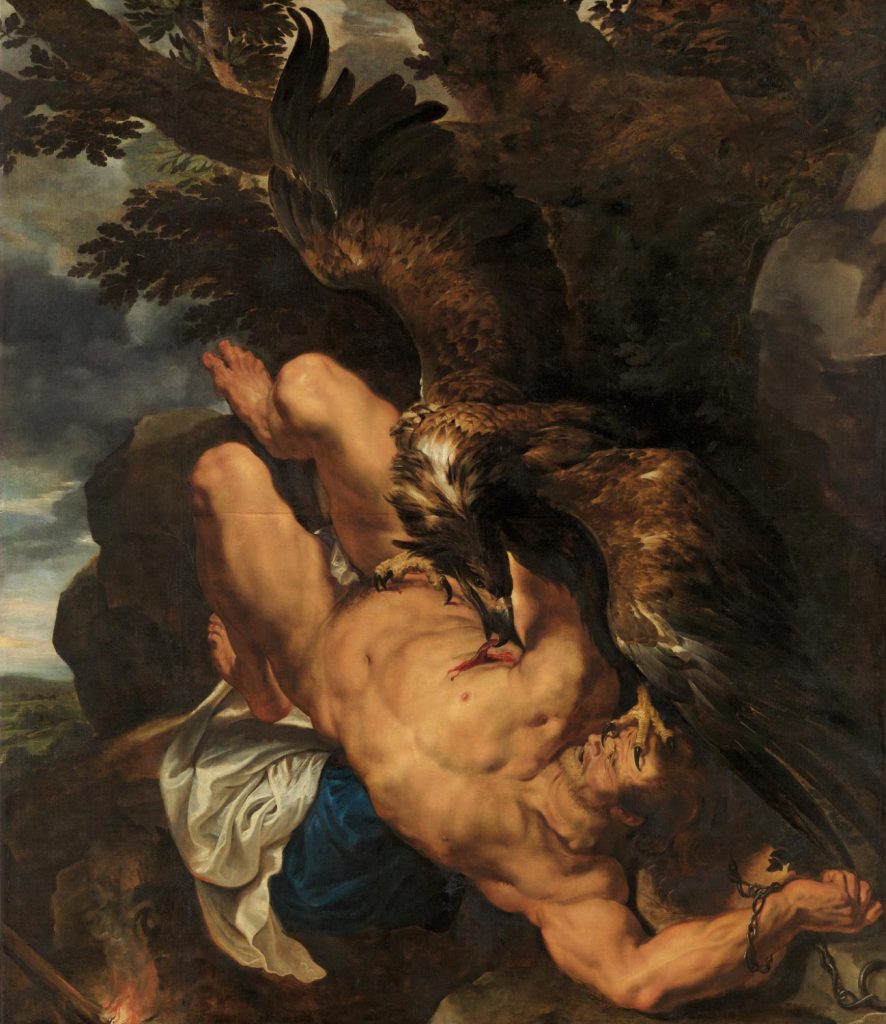
Male nudes in art: Peter Paul Rubens, Prometheus Bound, c. 1611-1618, Philadelphia Museum of Art, Philadelphia, PA, USA.
Prometheus Bound is inspired by Aeschylus’ play Prometheus Bound. Prometheus the Titan had rebelled against Zeus and stole the fire to give to mankind. In return, he was punished, by having an eagle eat his liver. Prometheus is usually depicted as bound to a rock but in this dramatic painting, the figure is lying on the ground, his hands chained. The eagle was painted by Frans Snyders, a master in paintings of animals, in particular birds. The heavily muscular Prometheus is shown in agony and his body is tense. While Rubens is depicting a classical scene, Prometheus is a celebration and glorification of the male body.
Alexandre Cabanel
Alexandre Cabanel (1823-1889) was a French painter known for painting historical, classical, and religious subjects.
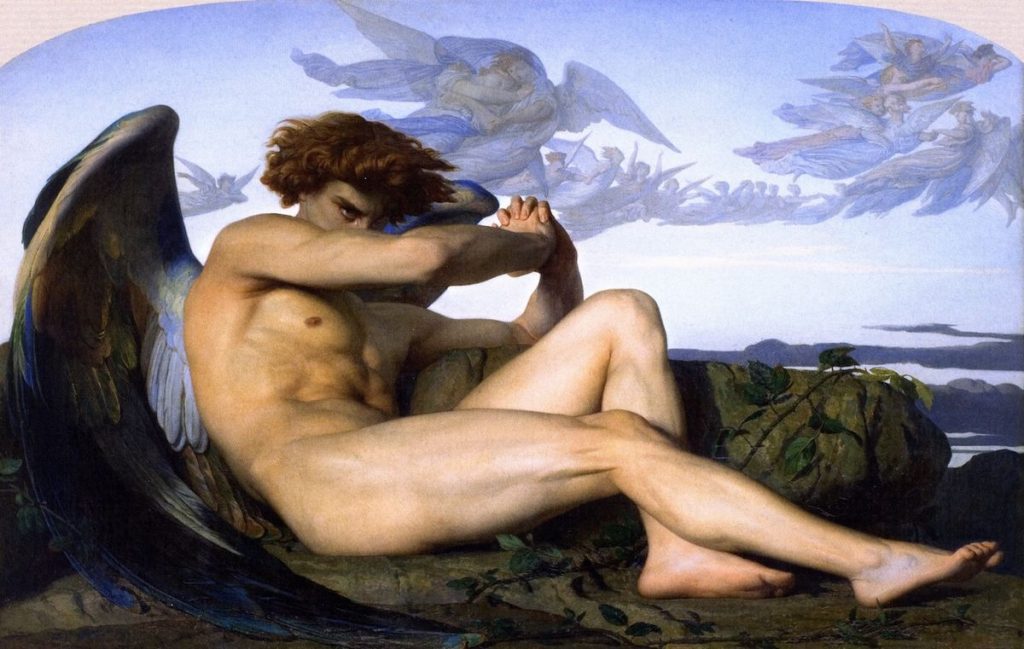
Male nudes in art: Alexandre Cabanel, The Fallen Angel, 1847, Musée Fabre, Montpellier, France.
Cabanel’s The Fallen Angel depicts Lucifer and the other angels who rebelled against an authoritarian God and were thrown out of heaven, as a punishment. The painting could have been inspired by John Milton’s Paradise Lost. Lucifer is smoldering with rage against God, his eyes are red and there is a tear waiting to fall. However, his posture with clasped hands, erect wings, and every muscle flexed with potential energy suggest he is ready to take flight. For this handsome prince of Hell, the fight has just begun!
The Ambitious Nude
Charles Paul Landon
Charles Paul Landon (1760-1826) was a French painter and popular writer on art and artists.
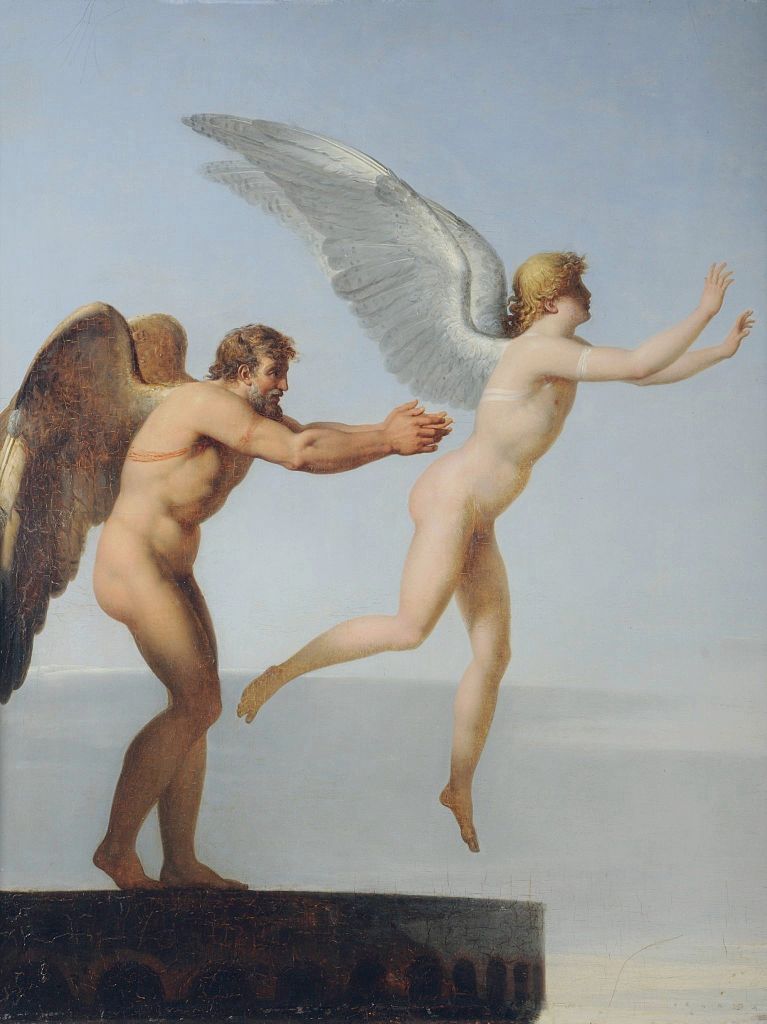
Male nudes in art: Charles Paul Landon, Icarus and Daedalus, 1799, Musée des Beaux-Arts et de la Dentelle, Alençon, France.
The story of Icarus and Daedalus was a popular theme for paintings inspired by Ovid’s Metamorphoses. The story has been interpreted as a cautionary tale against being over-ambitious. Most paintings depict the fall of Icarus when his wings melted. Icarus and Daedalus depicts the father and son pair at the moment when Icarus takes flight. Both nude figures are examples of classical simplicity and idealism. The father and son relationship is evident, Daedalus is cautiously helping Icarus to fly and he is worried. Icarus is looking up at the sky, thinking about how high he will fly.
The Affectionate Nude
Pierre-Auguste Renoir
Pierre-Auguste Renoir (1841-1919), also known as Auguste Renoir was a leading French Impressionist artist.

Male nudes in art: Pierre-Auguste Renoir, Young Boy with a Cat, 1868, Musée d’Orsay, Paris, France.
Young Boy with a Cat is an unusual painting by Renoir. Unlike his paintings which are full of Parisian men and women in outdoor spaces, this painting is a male nude. The youth is standing with his back towards the viewer. He is affectionately caressing the cat and his gaze is fixed somewhere in the distance. The identity of the boy is not known but the interior space suggests he belongs to an affluent class. What is striking is the coldness of the boy’s skin when contrasted against the warmth of the bond between him and his pet.
The Angry Nude
François-Léon Benouville
François-Léon Benouville (1821-1859) was a French painter known for his Neoclassical paintings. He was the contemporary of Alexandre Cabanel. Incidentally, both their paintings discussed here deal with anger and humiliation.
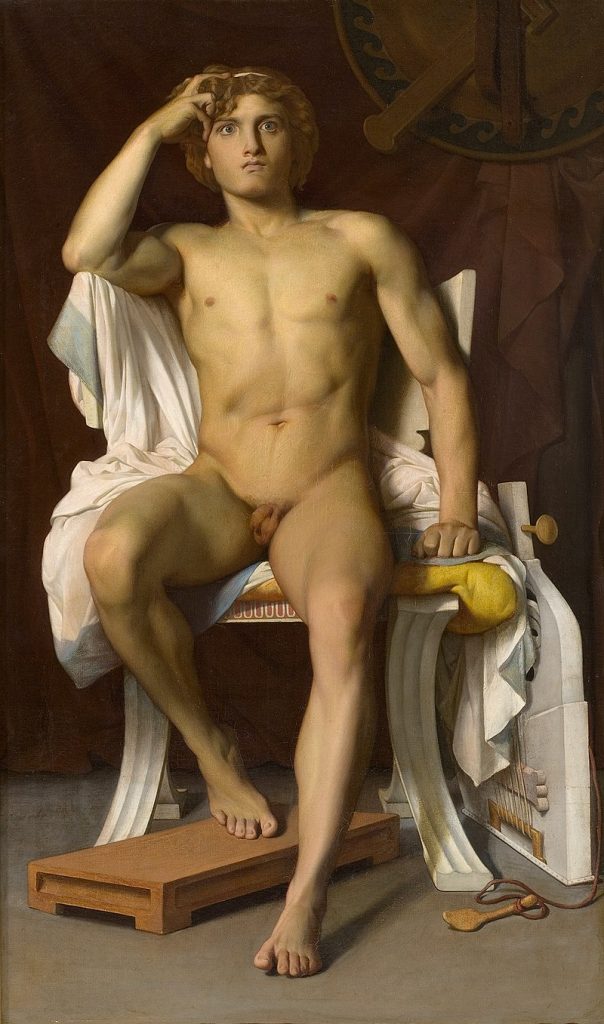
Male nudes in art: François-Léon Benouville, The Wrath of Achilles, 1847, National Gallery of Australia, Parkes, Australia.
In The Wrath of Achilles, Benouville portrays a young Greek hero from Homer’s Iliad. This is an integral episode in the story, where Achilles is nursing his anger against Agamemnon and refuses to fight against the Trojans. This is the moment when Agamemnon’s envoys come to persuade Achilles to fight. His fingers are clenched, eyes wide open, and one foot ready to rise to his calling.
The Athletic Nude
Eugène Jansson
Eugène Jansson (1862-1915) was born and lived all his life in Stockholm. Jansson could be described as the first gay Swedish painter and he never denied his sexuality.

Male nudes in art: Eugène Jansson, Ring gymnast I, 1911, National Gallery of Victoria, Melbourne, Australia.
Not since antiquity, have the bodies of athletes been depicted in this way. Like Munch, Jansson also portrayed the “vitality” of movement. The model for Ring gymnast I was possibly Knut Nyman, his close companion, but he could also be a sailor whom Jansson met at the bath-houses. In Ring gymnast I, Jansson celebrates the male nude figure as an athlete performing acrobatic exercises in an interior space.
The Bathing Nudes
Gustave Caillebotte
Gustave Caillebotte (1848-1894) was a French painter, who painted in Impressionistic and Realistic styles. He was also interested in photography.
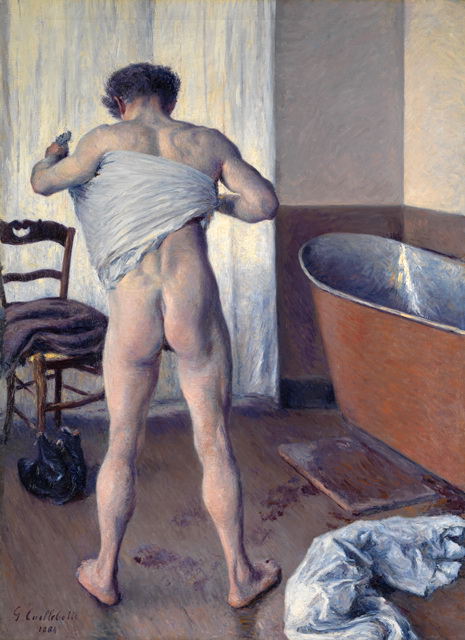
Male nudes in art: Gustave Caillebotte, Man at His Bath, 1884, Museum of Fine Arts, Boston, MA, USA.
The Man at His Bath depicts a very private moment in a painting. The young man is drying himself after a bath, and is neither posing for the painting nor has any intention of being seen. It is the viewer who is intruding into his private space, led in by the painter. Does he share a close relationship with the artist?
Thomas Eakins
Thomas Cowperthwait Eakins (1844-1916) was an American painter, photographer, and art educator. Eakins mainly painted the people of his hometown, Philadelphia, including his family, friends, and pupils.
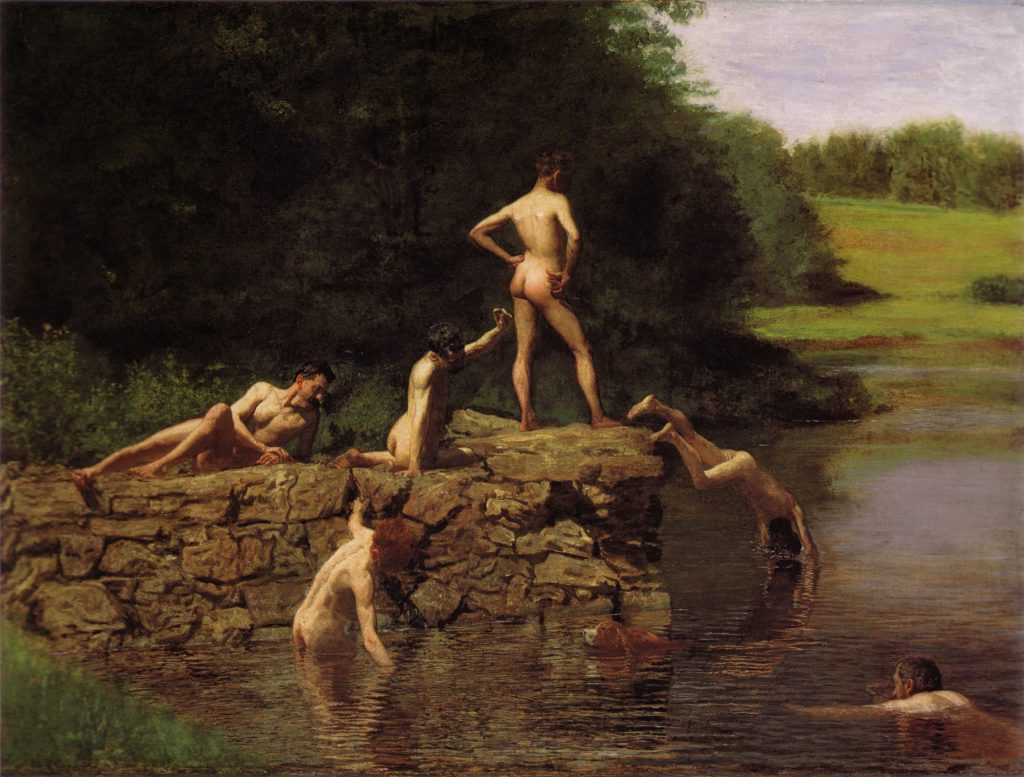
Male nudes in art: Thomas Eakins, Swimming, 1885, Amon Carter Museum of American Art, Fort Worth, TX, USA.
In Swimming (or Swimming Hole), Eakins painted six nude male swimmers, outdoors, in full sunlight. Eakins was also depicting his vision of Arcadia, where men could be free, bathe, and frolic together. The male bodies are painted in motion which is an influence of his photographic skills. The nudes in the painting are his friends and students and the figure swimming toward the dog is Eakins himself.
Edvard Munch
Edvard Munch (1863-1944) was a Norwegian painter who studied at the Royal School of Art and Design in Kristiania (today’s Oslo).
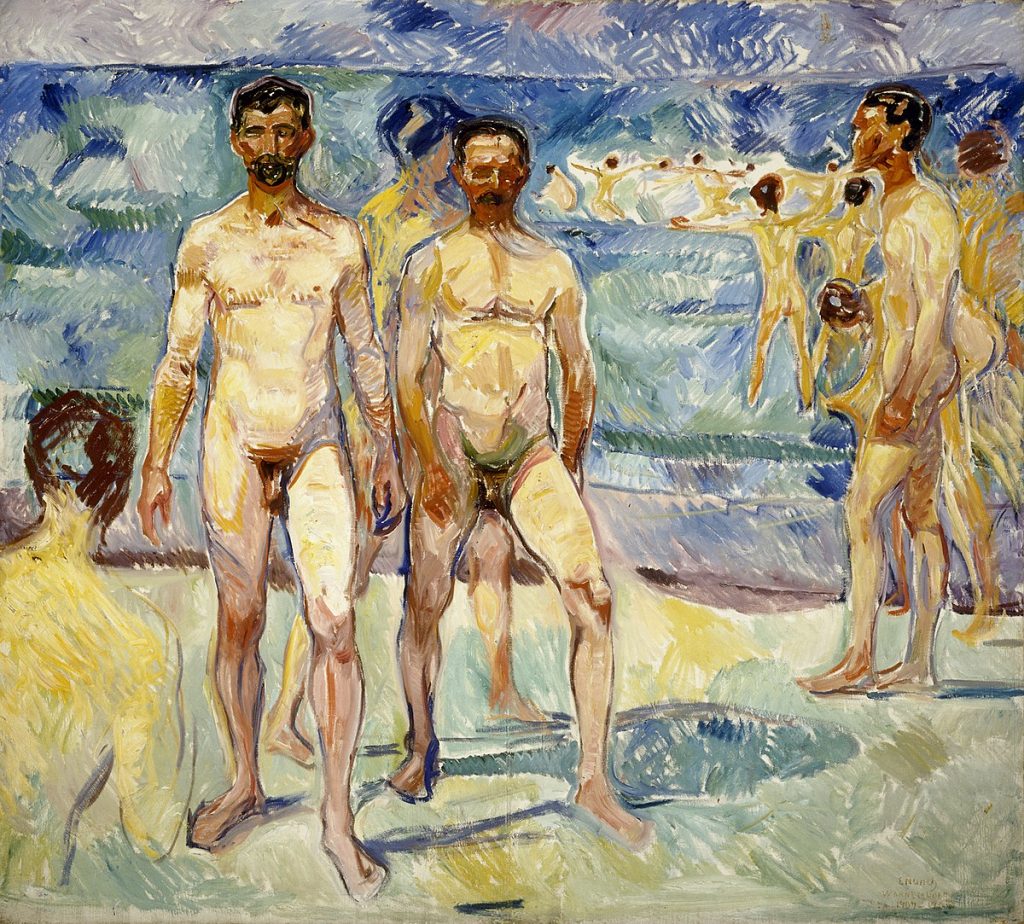
Male nudes in art: Edvard Munch, Badande män (Bathers), 1907, Ateneum Art Museum, Helsinki, Finland.
Munch’s Bathers portray a popular cultural phenomenon of the 20th century. Health spas, gymnasiums, and nudism were increasingly gaining popularity in Europe. The painting shows a group of virile, muscular, naked men emerging from the cool, turquoise sea after a swim. Naked youth and men were particularly associated with ‘vitalism’, the magical life force.
Henry Scott Tuke
Henry Scott Tuke (1858-1929) was a British painter and photographer. He is best known for painting nude boys and young men, bathing, or in outdoor spaces. His models were local swimmers and fishermen.
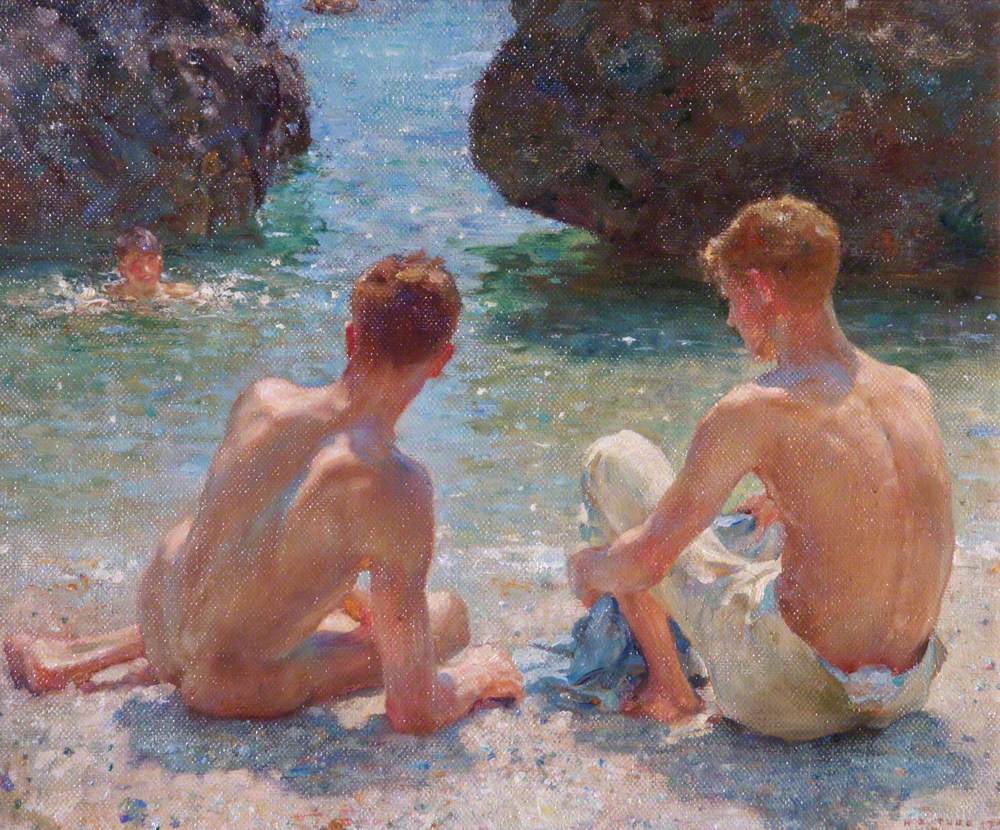
Male nudes in art: Henry Scott Tuke, Comrades, 1927, Leamington Spa Art Gallery & Museum, Warwickshire, UK.
The Critics shows one of the recurring themes in Tuke’s paintings. Two nude adolescent boys sitting on the beach. It is a sunny and warm day, perfect for a swim. The boys are not posing but seem to be immersed in observing their surroundings. The painting is also a shift from the heavily muscular and eroticized images of male bodies. Tuke was also the master of light, look at the glistening sea!
The Nudes at Work
Frédéric Bazille
Jean Frédéric Bazille (1841-1870) was a French Impressionist painter. He preferred figurative paintings within a landscape.
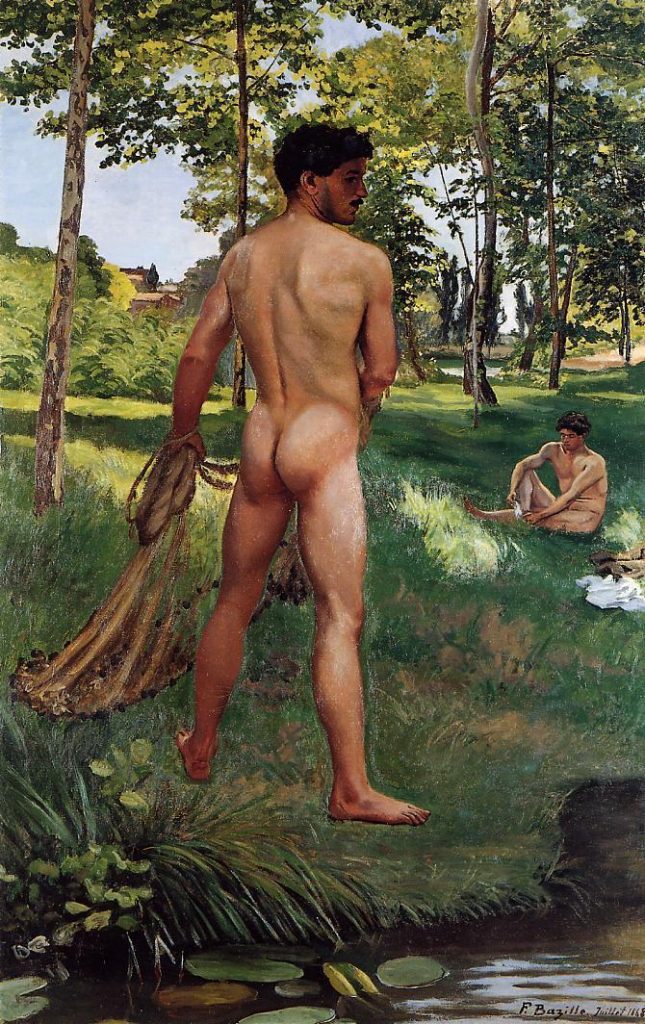
Male nudes in art: Frédéric Bazille, Fisherman with a Net, 1868, Fondation Rau pour le Tiers-Monde, Zurich, Switzerland.
Bazille’s Fisherman with a Net depicts two male nudes. Their bodies are created perfectly according to the principles of human body proportions. The fisherman has his back towards the viewer and he is ready to cast the net. The setting is most likely the River Lez, outside of Montpellier.
The Nude Self-Portraits
Albrecht Dürer
Albrecht Dürer (1471-1528) was a German painter and printmaker. Among his paintings, his self-portraits are quite remarkable. He painted the first one at the age of 13.

Male nudes in art: Albrecht Dürer, Nude self-portrait, c. 1509, The Germanisches National Museum, Nuremberg, Germany.
In Nude self-portrait, Dürer paints himself in fragments, his hands and parts of his legs are missing. His torso is intact and his gaze is fixed on the viewer. Dürer used a mirror to paint his self-portraits. Usually, he would dress up in elaborate costumes, holding a thistle or posing as Christ, this self-portrait is quite unconventional. He is standing nude, wearing only a hairnet, with black background on green paper. Perhaps, the painting was a practice study in self-reflection. Who are we, when the clothes are removed?
Richard Gerstl
Richard Gerstl (1883-1908) was a talented painter who was accepted into the Academy of Fine Arts, Vienna, at the age of 15. Ten years later he, unfortunately, died of suicide. In the fin-de-siècle (end of the century) Austria, suicide was fairly common among young artists and intellectuals.
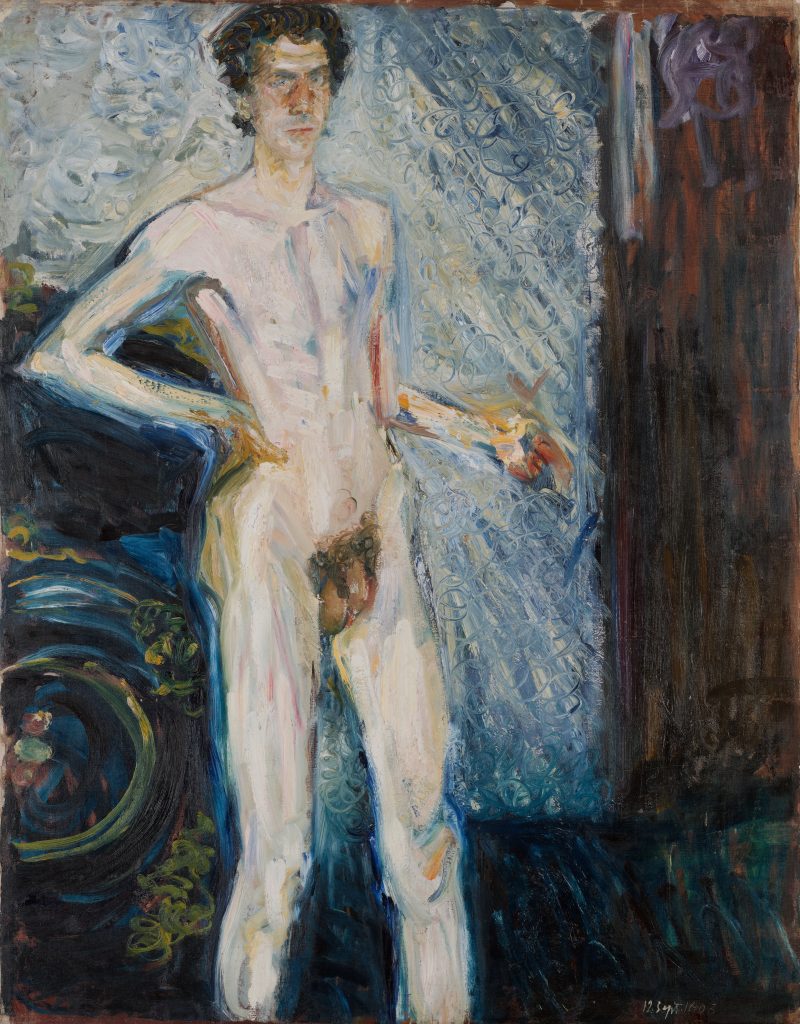
Male nudes in art: Richard Gerstl, Nude Self-Portrait with Palette, 1908, Leopold Museum, Vienna, Austria.
Nude Self-Portrait with Palette was painted just before Gerstl died by hanging himself at the age of 25. This portrait is more about his inner turmoil rather than a celebration of his masculinity. Gerstl was having an affair with a married woman and Arnold Schoenberg the husband had found out about it.
Egon Schiele
Egon Schiele (1890-1918) was an Austrian figurative painter. Most of his works are portraits of women and self-portraits, noted for intense sexuality and eroticism. He was also one of the early Expressionist artists.
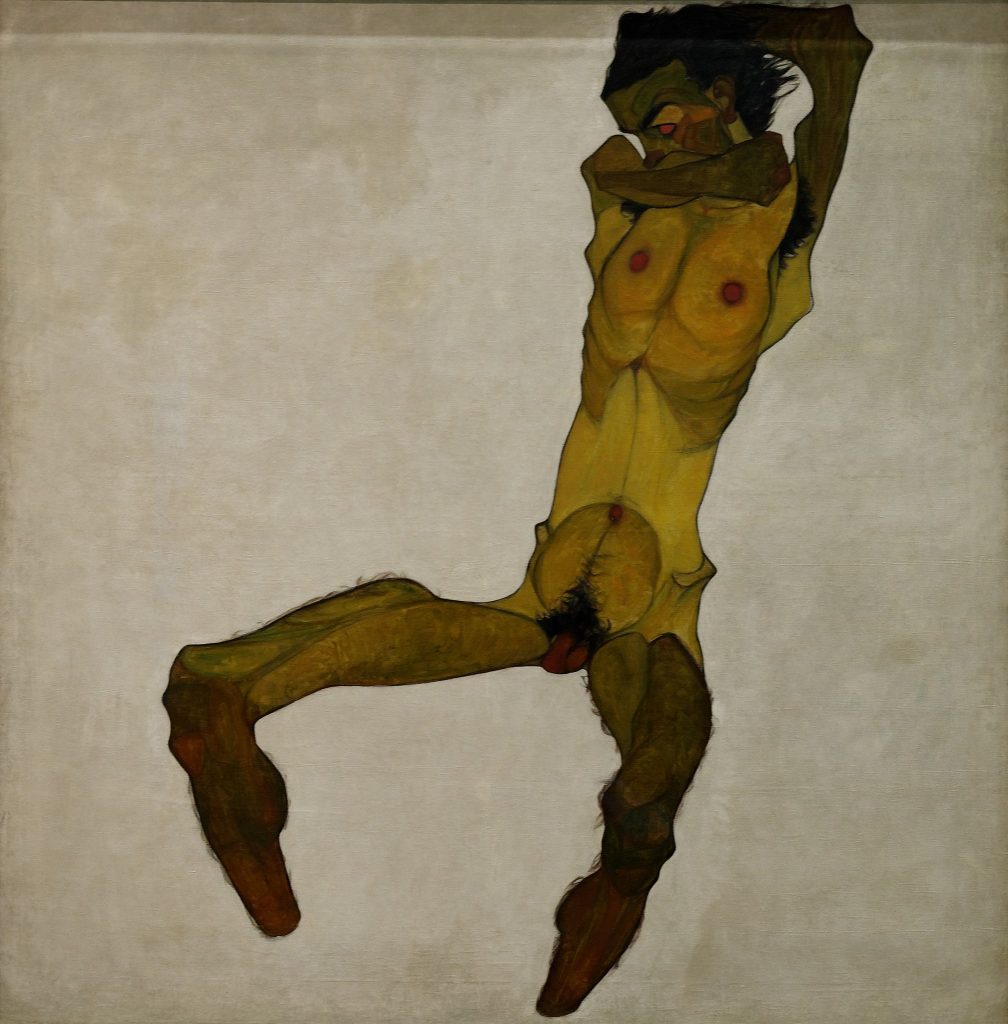
Male nudes in art: Egon Schiele, Seated Male Nude (Self-Portrait), 1910, Leopold Museum, Vienna, Austria.
In Seated Male Nude (Self-Portrait), Schiele’s body is fragmented. His hands and feet are missing. The pose is twisted, face half-covered and legs wide open to expose his genitals. His body is thin and his ribs are exposed. The background is plain with no other object. The portrait is deliberately deformed to the point of caricature, a way for Schiele to discover himself.
Lucian Freud
Lucian Michael Freud (1922-2011) was a British painter, draughtsman, figurative artist, and well-known portraitist. Painter Working, Reflection, was painted when Freud turned 70. This is considered his boldest painting.
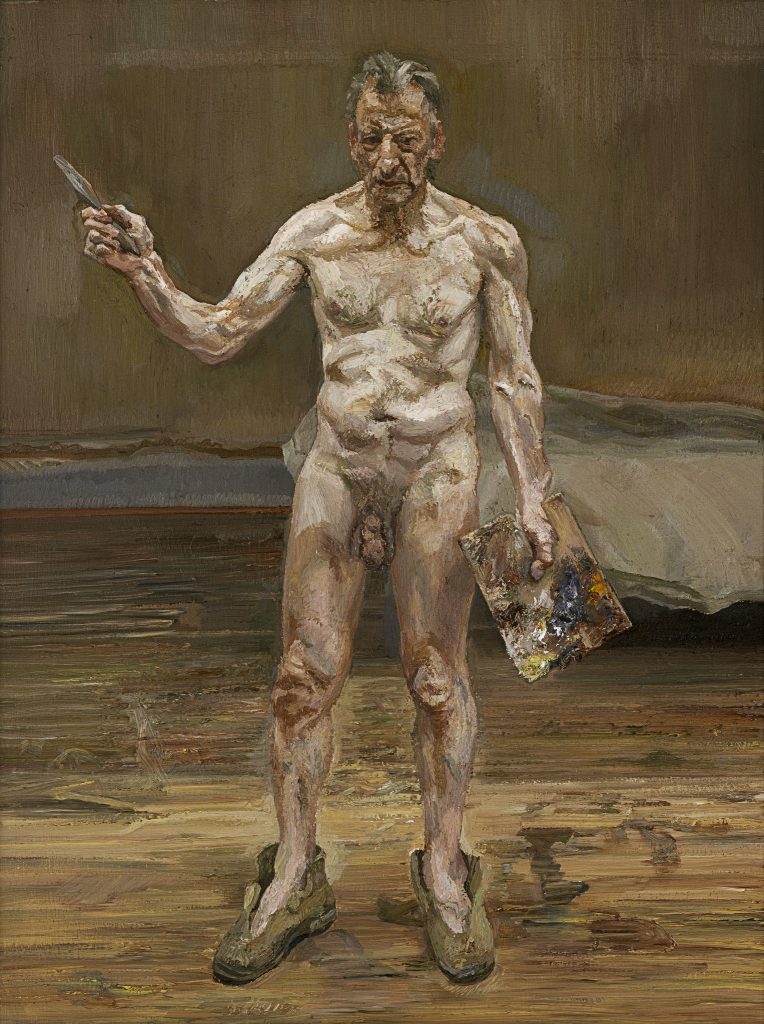
Male nudes in art: Lucian Freud, Painter Working, Reflection, 1993. The Lucian Freud Archive.
He stands nude in an empty room, there is a bed in the background, he is wearing brown shoes which merge with the color of the floor, and he is holding his palette and brush. According to Freud,
I felt very uneasy doing it. Seldom got so fed up with a model. But I thought, after putting so many other people through it, I ought to subject myself to the same treatment.
Interview, October 5, 2019, The New York Times.
Freud painted a self-portrait for every meaningful milestone in his life, especially birthdays. He was not ashamed of his aging body because it narrated the story of his life.
The Nude Studies
Jean-Auguste-Dominique Ingres
Jean-Auguste-Dominique Ingres (1780-1867) was a French Neoclassical painter. He aimed to become a painter of history but he is well-known for his portraits.
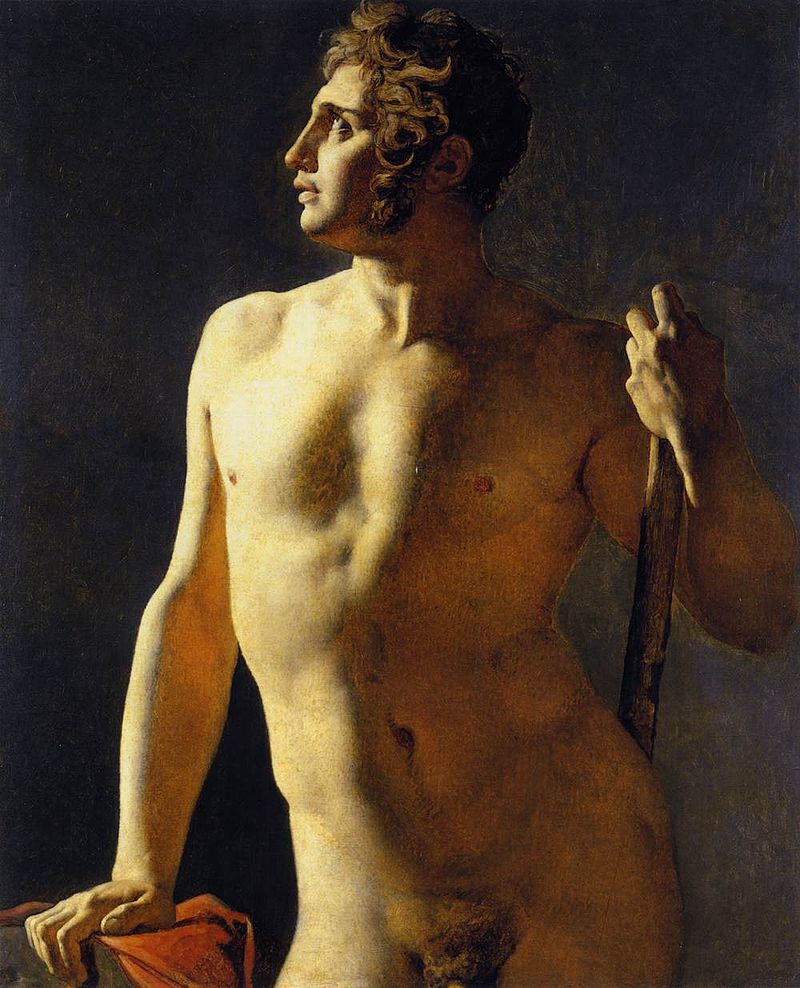
Male nudes in art: Jean-Auguste-Dominique Ingres, Study of a Male Nude, 1801, École des Beaux-Arts, Paris, France.
In the Study of a Male Nude, Ingres was shifting from Classicism to Realism. He replaced the ideals of purity and simplicity with a more muscular and realistic depiction of the male body. Ingres actually won a grand prize for painting the perfect male torsos at École des Beaux-Arts, Paris!
Théodore Chasseriau
Théodore Chassériau (1819-1856) was a French Romantic painter, known for his portraits and “Oriental” images.

Male nudes in art: Théodore Chasseriau, Study of Negro, 1838, Musée Ingres, Montauban, France.
The Study of Negro was inspired by Chassériau’s interest in the people of North Africa and the Middle East. The nude figure, who seems to be falling backward is the focus of the painting. His gaze is sideways and there is a plain background. There are two hands on the left – a study for the main model. Chassériau did not develop this painting further thus it remained a study of a nude male body.
Edgar Degas
Edgar Degas (1834-1917) was a French artist known for his pastel drawings and oil paintings of ballerinas. He is also considered the founder of Impressionism.
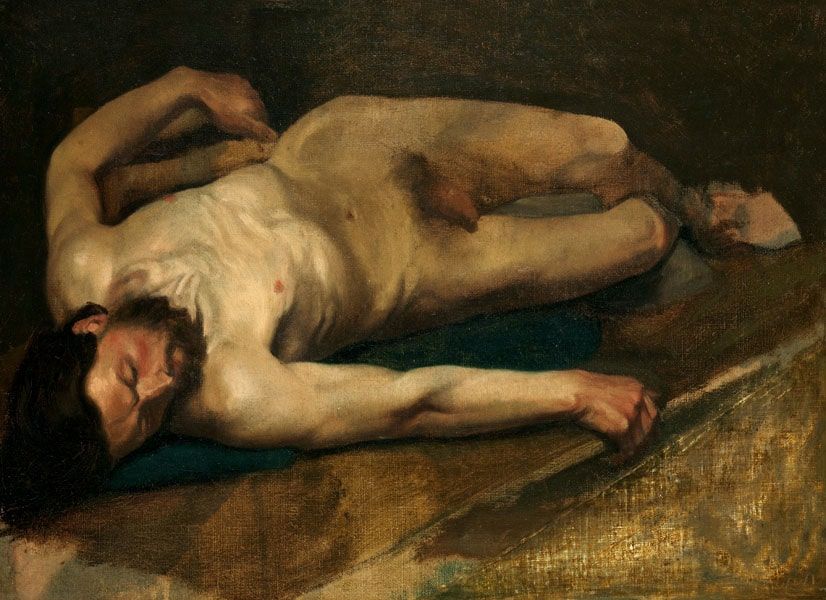
Male nudes in art: Edgar Degas, Male Nude, 1856, The Metropolitan Museum of Art, New York, NY, USA.
Degas painted this study as an art student in Paris, where he was training to be a history painter. In fact, he painted this nude figure on top of another sketch and left it unfinished.
The Realistic Nudes
William Etty
William Etty (1787-1849) was a British painter famous for painting nudes and still life. Etty’s ability to paint realistic flesh tones was remarkable. Almost all his paintings contained one nude figure, male or female, and Etty gained a reputation for indecency. Despite being an acclaimed artist, Etty continued to study in life classes and the result is for us to see!
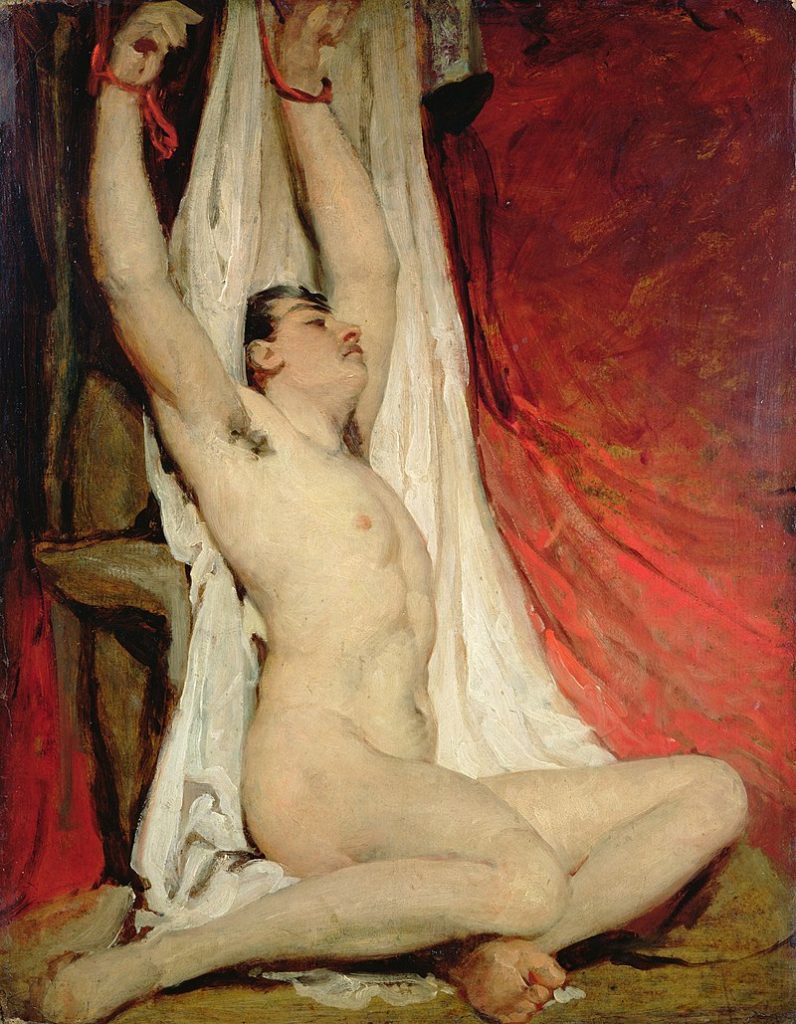
Male nudes in art: William Etty, Male Nude, with Arms Up-Stretched, 1828, York Museums and Gallery Trust, York, UK.
It was suggested that Male Nude, with Arms Up-Stretched, was meant to be hung up horizontally, it was more likely a study for another painting Descent from the Cross.
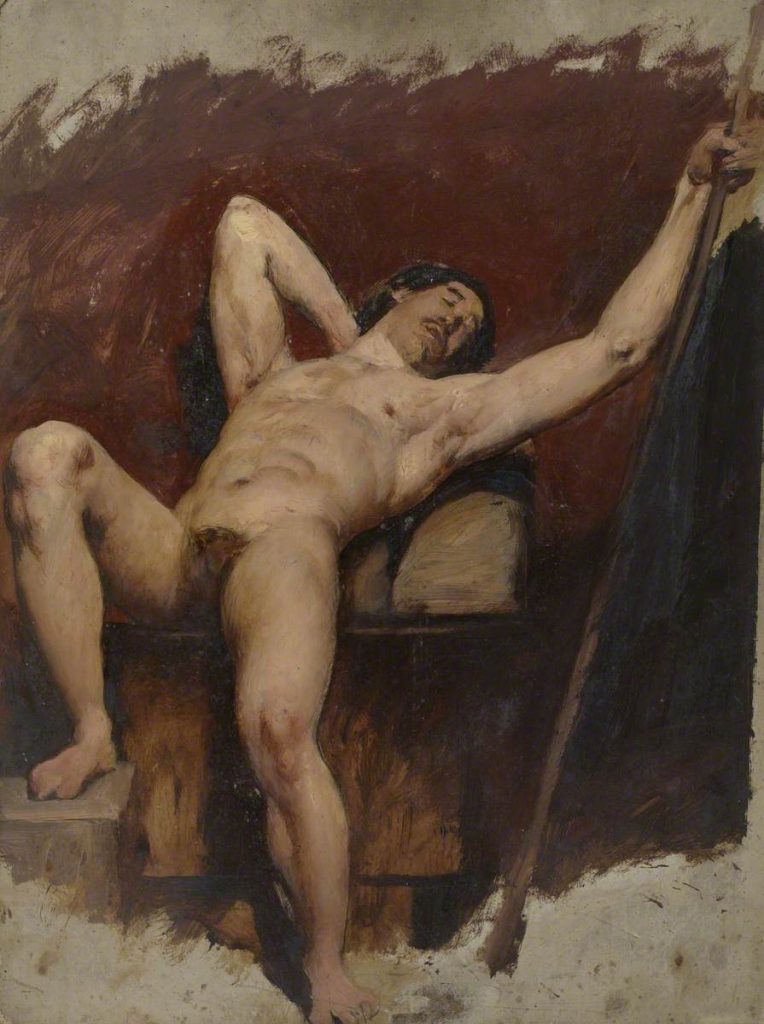
Male nudes in art: William Etty, Reclining Male Nude, raised right Knee, 1815-1845, The Samuel Courtauld Trust, The Courtauld Gallery, London, UK.
Interestingly, Etty’s male models were lifeguards or men he met at the public bathhouses. He thought that they had the best muscular physique. We could not agree more with him, so we dedicate this whole section to his models!
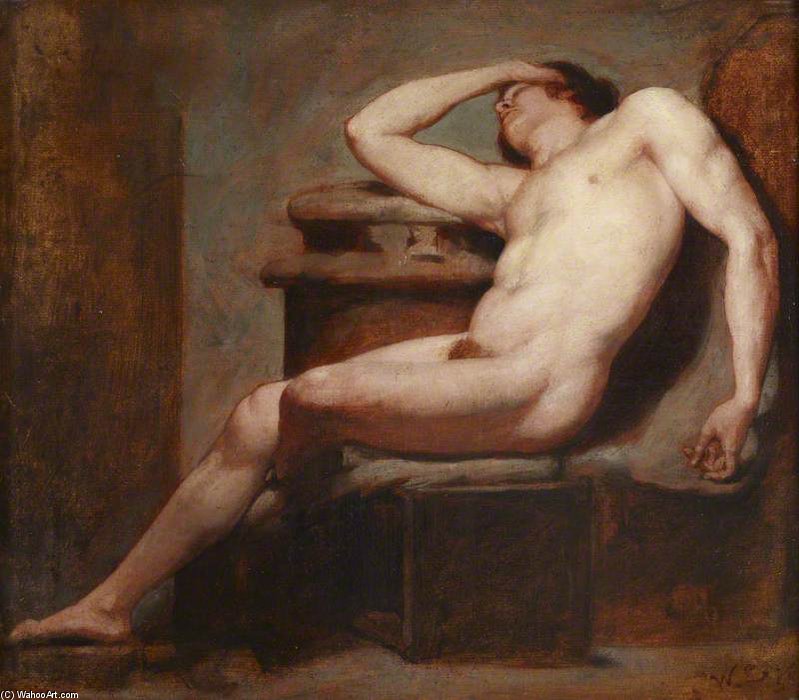
Male nudes in art: William Etty, Academic Study of a Reclining Male Nude Asleep, 1836, Anglesey Abbey, National Trust, UK.
Etty’s models often posed either seated, standing, and reclining. What remained constant was the realistic depiction of the male body.
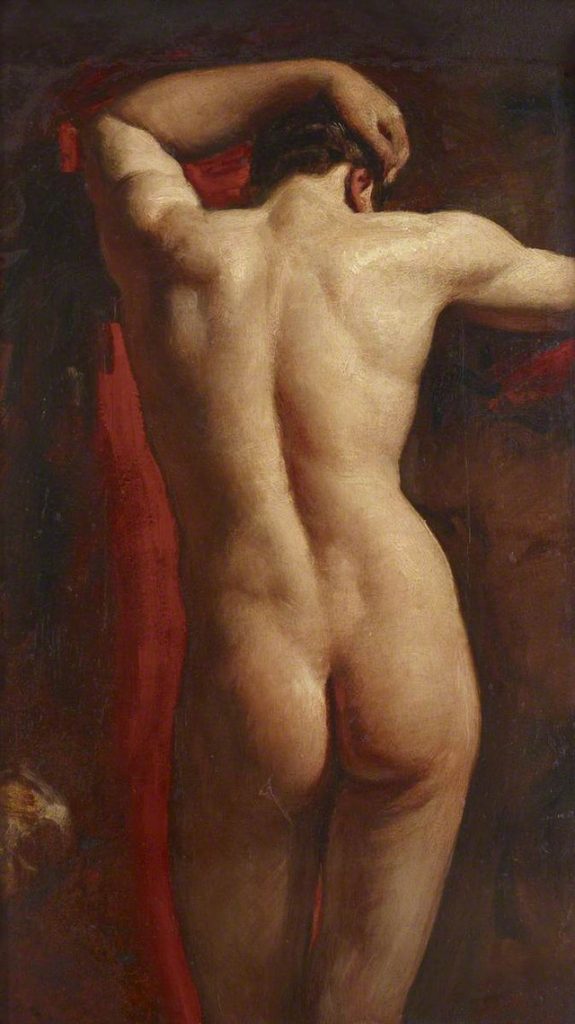
Male nudes in art: William Etty, Academic Study of a Male Nude, seen from Behind, c. 1830-1835, Anglesey Abbey, National Trust, UK.
Academic Study of a Male Nude, Seen from Behind is a three-quarter length study of a nude figure. It was first exhibited at the Wakefield Industrial Exhibition. To read more on the best bums in art read here!
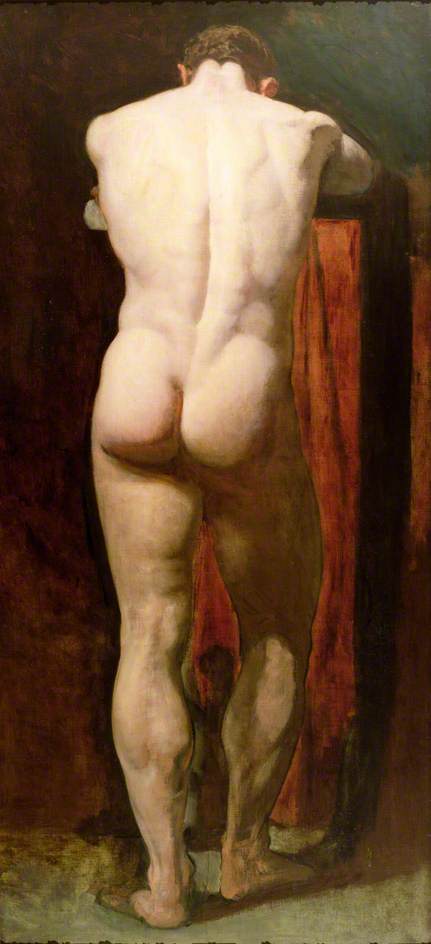
Male nudes in art: William Etty, Standing Male Nude, Towneley Hall Art Gallery & Museum, Burnley, UK.
The Standing Male Nude is perhaps the completed painting of the Academic Study of a Male Nude, Seen from Behind. Here, the weight of the body is on the left leg. As always, Etty’s models do not look at the viewer.
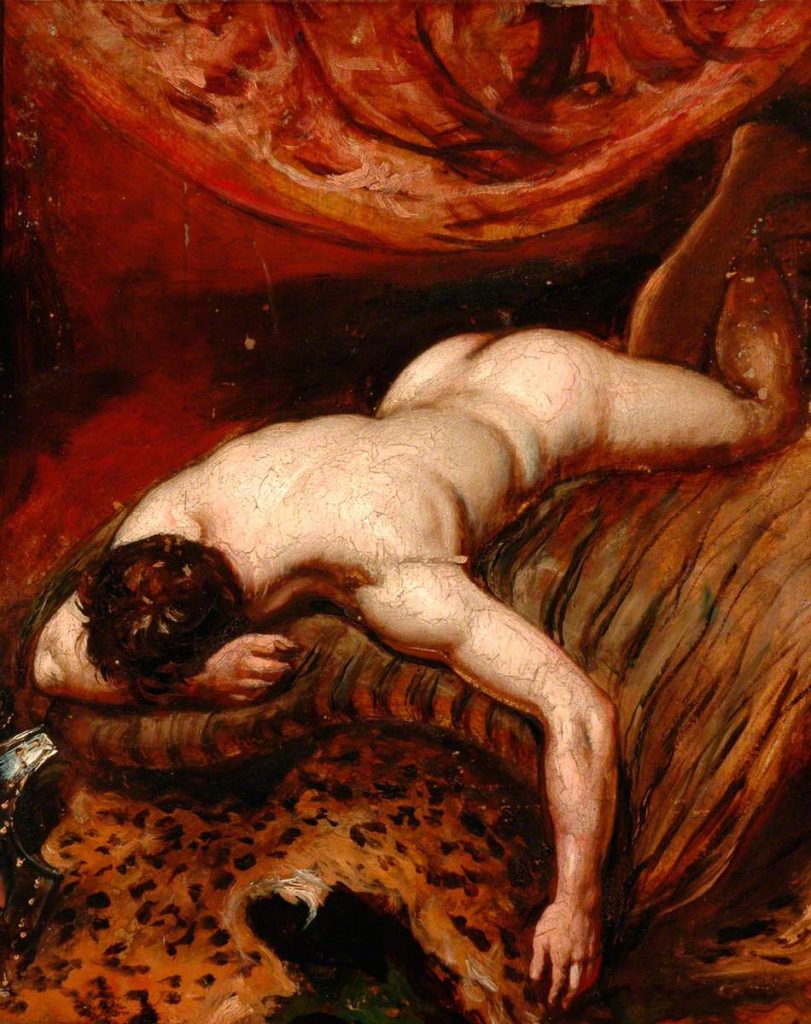
Male nudes in art: William Etty, Man Lying Face Down, Scarborough Museums Trust, Scarborough, UK.
Man Lying Face Down is a painting with an unusual background, the animal skin! Notice the use of scarlet drapery in the paintings’ backgrounds and the stylized poses of his models!
